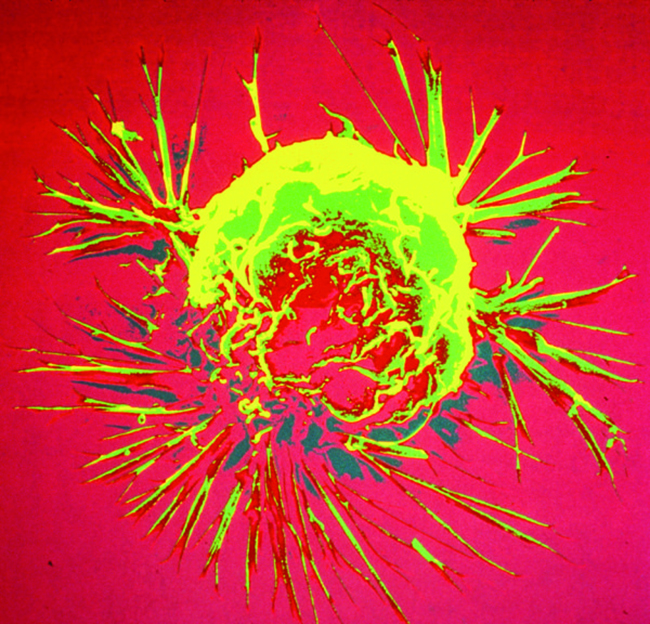![Researchers have identified a novel metabolic pathway that helps cancer cells thrive in conditions that are lethal to normal cells. [National Cancer Institute, NIH]](https://genengnews.com/wp-content/uploads/2018/08/28216_large1422477191.jpg)
Researchers have identified a novel metabolic pathway that helps cancer cells thrive in conditions that are lethal to normal cells. [National Cancer Institute, NIH]
Being attached to the extracellular matrix (ECM) provides cells with numerous advantages for survival, for instance, receiving much needed growth stimuli. However, for malignant cells to function, they must overcome their anchorage-dependent growth—a scenario that is associated with increased production of reactive oxygen species (ROS) and altered glucose metabolism.
Now, researchers at the Children's Medical Center Research Institute at UT Southwestern (CRI) believe they have uncovered a novel metabolic pathway that helps cancer cells thrive in conditions that would otherwise be lethal to healthy cells.
“It's long been thought that if we could target tumor-specific metabolic pathways, it could lead to effective ways to treat cancer,” explained senior study author Ralph DeBerardinis, M.D., Ph.D., associate professor, and director of CRI's Genetic and Metabolic Disease Program. “This study finds that two very different metabolic processes are linked in a way that is specifically required for cells to adapt to the stress associated with cancer progression.”
This new study describes an alternate version of two well-known metabolic pathways, the pentose phosphate pathway (PPP) and the Krebs cycle, to defend against ROS that destroy cells via oxidative stress.
The findings from this study were published recently in Nature in an article entitled “Reductive Carboxylation Supports Redox Homeostasis During Anchorage-Independent Growth.”
Previous work from Dr. DeBerardinis' laboratory found that the Krebs cycle, a series of chemical reactions that cells use to generate energy, could reverse itself under certain conditions to nourish cancer cells.
Dr. DeBerardinis also noted that cells “are dependent on matrix attachment to receive growth-promoting signals and to regulate their metabolism in a way that supports cell growth, proliferation, and survival.” Detachment from the matrix results in a sudden increase in ROS that is lethal to normal cells. Yet, cancer cells seem to have evolved workaround.
A landmark study from 2009 elucidated that healthy cells were destroyed when detached from the ECM. Moreover, in the same study, investigators found that inserting an oncogene into a normal cell caused it to behave like a cancer cell and survive detachment.
“Another Nature study, this one from CRI Director Dr. Sean Morrison's laboratory in November 2015, found that the rare skin cancer cells that were able to detach from the primary tumor and successfully metastasize to other parts of the body had the ability to keep ROS levels from getting dangerously high,” Dr. DeBerardinis remarked.
Dr. DeBerardinis and his team worked from the premise that the two findings were pieces of the same puzzle and that a crucial part of the picture seemed to be missing.
It had been well known that the PPP was an important source of nicotine adenine dinucleotide phosphate (NADPH), which provides a source of reducing electrons to scavenge ROS; however, the PPP produces NADPH in the cytosol, whereas the ROS are generated primarily in another subcellular structure called the mitochondria.
“If you think of ROS as fire, then NADPH is like the water used by cancer cells to douse the flames,” Dr. DeBerardinis noted. But how could NADPH from the PPP help deal with the stress of ROS produced in an entirely different part of the cell? “What we did was to discover how this happens.”
The CRI team was able to demonstrate that cancer cells use a “piggybacking” system to carry the reducing electron from the PPP into the mitochondria. This movement involves an unusual reaction in the cytosol that transfers reducing equivalents from NADPH to a molecule called citrate, similar to a reversed reaction of the Krebs cycle.The citrate then enters the mitochondria and stimulates another pathway that results in the release of reducing electrons to produce NADPH right at the location of ROS creation, allowing the cancer cells to survive and grow without the benefit of matrix attachment.
“We knew that both the PPP and Krebs cycle provide metabolic benefits to cancer cells. But we had no idea that they were linked in this unusual fashion,” Dr. DeBerardinis stated. “Strikingly, normal cells were unable to transport NADPH by this mechanism, and died as a result of the high ROS levels.”
The researchers stressed that their findings were based on cultured cell models and more research will be necessary to test the role of the pathway in living organisms.
“We are particularly excited to test whether this pathway is required for metastasis because cancer cells need to survive in a matrix-detached state in the circulation in order to metastasize,” Dr. DeBerardinis concluded.


